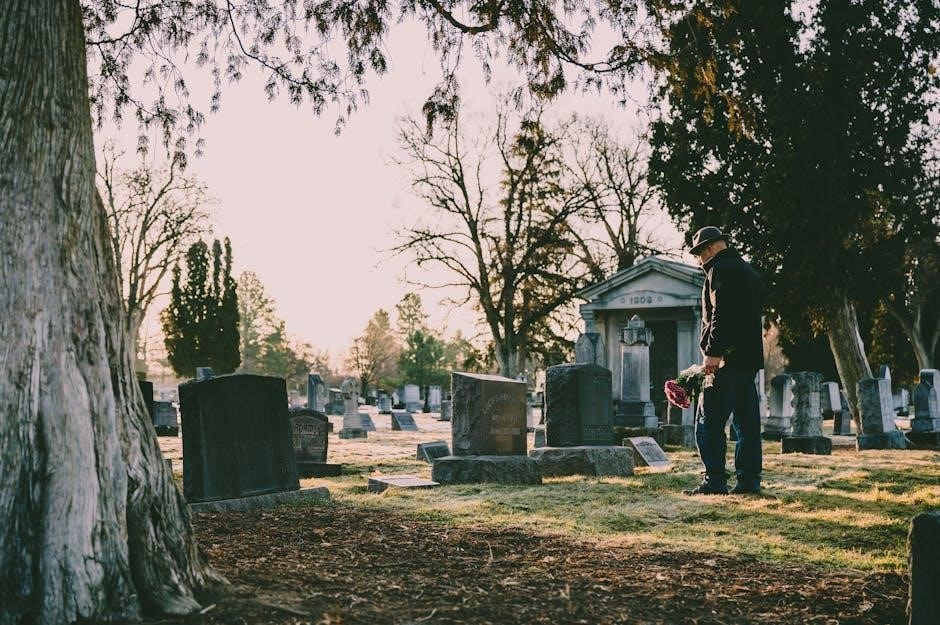
“Death Be Not Proud” by John Donne is a profound Holy Sonnet challenging death’s authority, personifying it as a powerless figure, and emphasizing eternal life’s promise.
1.1 Background and Context of the Poem
Written by John Donne in 1631, “Death Be Not Proud” is part of his Holy Sonnets, reflecting his spiritual and philosophical contemplation of mortality. The poem, also known as Holy Sonnet 10, was composed during a period of personal loss and religious reflection in Donne’s life. It challenges the perception of death as a fearsome entity, instead presenting it as a natural transition to eternal life. The poem’s themes resonate with 17th-century religious thought, emphasizing faith and the afterlife.
1.2 John Donne’s Place in English Literature
John Donne is celebrated as a leading figure in English literature, particularly known for his metaphysical poetry. His works, including “Death Be Not Proud,” showcase his unique blend of intellectual depth, emotional complexity, and spiritual insight. Donne’s poetry, characterized by its intricate imagery and philosophical themes, earned him recognition as a major poet, influencing later literary movements. His writing remains timeless, resonating with readers for its exploration of universal themes like mortality and faith.

The Poem’s Structure and Form
Death Be Not Proud is a sonnet, structured as a Holy Sonnet, with a traditional rhyme scheme and 14 lines, emphasizing its thematic depth through poetic form.
2.1 Sonnet Structure and Its Significance
The poem adheres to the traditional sonnet structure, with 14 lines and a rhyme scheme of ABBA ABBA CDCD EE. This form underscores the thematic gravity, as the rigid structure contrasts with the fluid, metaphysical ideas. The sonnet’s volta shifts the tone, moving from addressing Death’s pride to asserting its illusion. The compressed form intensifies the argument, making the poem a powerful exploration of mortality and eternal life.

2.2 Use of Metaphysical Imagery
Donne employs metaphysical imagery to diminish Death’s power, likening it to “rest and sleep,” which are merely temporary states. Death is personified as a “slave to fate, chance, and kings,” emphasizing its lack of true authority. The imagery of sleep and rest underscores the idea that death is not an end but a transition, reinforcing the poem’s central theme of eternal life and the illusion of Death’s dominion. This metaphysical approach challenges conventional perceptions of mortality.
Themes and Motifs
The poem explores themes of mortality, challenging Death’s authority, and the promise of eternal life, using motifs like personification and paradox to diminish Death’s perceived power.
3.1 Personification of Death
In “Death Be Not Proud,” Donne personifies Death as a proud entity, addressing it directly to challenge its authority. By giving Death human-like qualities, Donne diminishes its fearsome reputation, portraying it as a mere illusion of power. This personification allows Donne to confront Death boldly, asserting its inability to truly kill or dominate. The poem strips Death of its intimidation, reducing it to a powerless figure, emphasizing its role as a transition to eternal life rather than an end.

3.2 The Concept of Eternal Life
Donne’s poem emphasizes the concept of eternal life, portraying death as a temporary state rather than an end. He argues that death is merely a “short sleep” before awakening to eternal existence. This belief in an afterlife diminishes death’s power, revealing it as a transitional phase. Donne’s Christian faith shines through, as he suggests that death’s authority is an illusion, and true life continues beyond the grave, where death itself will cease to exist.
3.3 The Illusion of Death’s Power
Donne undermines death’s perceived power by exposing it as an illusion. Death, often feared as mighty, is revealed as a mere servant to fate, chance, and human actions. Donne argues that death’s authority is false, as it cannot truly kill or dominate. Instead, death is a natural transition, a “short sleep” before eternal life begins. This perspective diminishes death’s intimidation, showing it as a temporary state rather than an end, thus stripping it of its feared dominion over humanity.

Style and Language
Donne’s metaphysical style shines through his use of irony, satire, and complex imagery, blending religious and philosophical themes to create a persuasive and profound exploration of mortality.
4.1 Use of Irony and Satire
John Donne employs irony and satire to diminish death’s perceived power, calling it “proud” yet highlighting its limitations. By labeling death a “slave to fate,” Donne undermines its authority, suggesting it is merely a transitional phase rather than an end. This ironic tone challenges conventional fears, presenting death as a servant to larger forces, thus stripping it of its intimidating aura and reducing it to a mere illusion of control. Donne’s satirical approach mocks death’s pretense of might, revealing its inherent weakness and the inevitability of eternal life. The use of such literary devices not only conveys his philosophical beliefs but also reinforces the poem’s central theme of death’s impotence against divine will. Through these techniques, Donne masterfully redefines death’s role, transforming it from a feared entity into a subordinate force, thereby comforting the reader with the promise of an afterlife. This clever manipulation of tone and language underscores Donne’s metaphysical perspective, blending theology with poetic artistry to create a persuasive and enduring argument against death’s dominion. Donne’s irony and satire thus serve as powerful tools in his rhetorical arsenal, allowing him to convey complex ideas with clarity and emotional resonance.
4.2 Religious and Philosophical Undertones
John Donne’s “Death Be Not Proud” is deeply infused with religious and philosophical themes, reflecting his metaphysical worldview. The poem challenges death’s authority by framing it as a mere transition to eternal life, a central Christian belief. Donne’s use of religious imagery, such as contrasting death’s powerlessness with God’s sovereignty, underscores the poem’s theological underpinnings. This philosophical perspective offers comfort, diminishing death’s fearfulness by emphasizing its role as a divine instrument rather than an end. The poem thus becomes a profound exploration of mortality, faith, and the promise of resurrection, blending Donne’s spiritual convictions with his intellectual rigor to create a work that transcends literary boundaries and speaks to universal human concerns about existence and the afterlife.
4.3 The Role of Rhetoric in the Poem
John Donne’s masterful use of rhetoric in “Death Be Not Proud” shapes a persuasive argument against death’s dominance. Through personification, paradox, and logical reasoning, Donne diminishes death’s authority, employing vivid imagery like “thou art not so” to undermine its might. The poem’s direct address and confrontational tone create a powerful dialogue, while its structured logic and emotional appeal reinforce Donne’s central message. Rhetorical devices like metaphor (“sleep past”) and irony (“Death shalt die”) amplify the poem’s impact, making it a compelling exploration of mortality and divine truth.
Key Lines and Their Analysis
The poem’s key lines, such as “Death, be not proud, though some have called thee,” challenge death’s authority, while “One short sleep past, we wake eternally” underscores eternal life’s promise.
5.1 “Death, be not proud, though some have called thee”
This iconic line introduces the poem’s central theme of challenging death’s authority. Donne personifies death as a proud figure, yet quickly undermines its power, suggesting it is neither mighty nor dreadful. The line sets a tone of defiance and irony, emphasizing death’s illusion of control. By addressing death directly, Donne establishes a confrontational yet philosophical tone, inviting readers to reconsider mortality and the promise of eternal life beyond death’s reach.
5.2 “For those whom thou thinkst thou dost overthrow”
This line underscores the illusion of death’s power, suggesting it does not truly “overthrow” anyone. Donne argues that death merely transitions souls to eternal life, diminishing its authority. The phrase highlights the transience of death’s influence, emphasizing its role as a temporary state rather than an end. By challenging death’s perceived dominance, Donne reinforces the poem’s central theme of mortality’s limitations and the promise of eternal existence beyond earthly life.
5.3 “One short sleep past, we wake eternally”
This line encapsulates Donne’s belief in the transience of death and the promise of eternal life. The phrase “one short sleep past” metaphorically describes death as a temporary rest, after which the soul awakens to eternal existence. Donne emphasizes that death is not an end but a transition, reinforcing the poem’s central theme of mortality’s limitations. The line underscores the triumph of eternal life over death’s illusion of power, offering hope and reassurance to the reader.
Historical and Cultural Context
Written in the 17th century, Donne’s poem reflects a time of religious introspection and philosophical inquiry, blending spirituality with metaphysical themes, characteristic of his era and influence.
6.1 The Era of John Donne’s Writing
John Donne wrote “Death Be Not Proud” in the early 17th century, a period marked by religious and philosophical transformation. The poem reflects the intellectual and spiritual atmosphere of the time, blending metaphysical themes with Christian theology. Donne’s work emerged during a era of heightened theological debate, where death and mortality were common subjects. His poetry, published posthumously, gained prominence in the 20th century, resonating with its profound exploration of human existence and the divine.
6.2 The Influence of Religious Thought
Religious thought deeply influenced John Donne’s “Death Be Not Proud,” reflecting his Christian beliefs. The poem explores themes of mortality, divine judgment, and eternal life, drawing on biblical concepts. Donne, an Anglican priest, used religious imagery to convey that death is not an end but a transition to eternal life. His work often intertwined theology with personal reflection, creating a spiritual depth that resonated with readers. This religious framework remains central to the poem’s enduring significance.
6.3 The Poem’s Reception Over Time
“Death Be Not Proud” initially gained popularity after Donne’s death, resonating for its profound themes. By the 20th century, it became a cornerstone of metaphysical poetry, celebrated for its intellectual depth and spiritual insight. Today, it remains a staple in academic curricula and literary discussions, with its exploration of mortality and eternal life continuing to inspire readers, solidifying its place as a timeless masterpiece in English literature.

Critical Reception and Interpretation
Critics praise “Death Be Not Proud” for its bold challenge to death’s power, employing metaphysical themes and rich imagery. Its intellectual depth and spiritual resonance have solidified its status as a masterpiece of English literature.
7.1 Modern Perspectives on the Poem
Contemporary scholars and readers continue to admire Donne’s audacity in confronting death, viewing the poem as a timeless exploration of mortality and transcendence. Its innovative use of personification and metaphysical imagery resonates deeply, offering comfort and philosophical insight. The poem’s themes of eternal life and the illusion of death’s power remain central to modern interpretations, ensuring its enduring relevance in literary and cultural discourse today.
7.2 Scholarly Debates About the Poem’s Meaning
Scholars debate the poem’s meaning, with some interpreting it as a religious statement on resurrection and others as a philosophical reflection on mortality. Donne’s use of personification and metaphysical imagery sparks discussions about whether the poem diminishes death’s power or highlights its inevitability. Some argue it reflects Donne’s personal struggles with faith and death, while others see it as a universal meditation on human existence and the afterlife.
7.3 The Poem’s Place in Donne’s Oeuvre

“Death Be Not Proud” stands as a cornerstone of Donne’s Holy Sonnets, showcasing his metaphysical style. It exemplifies his mastery of blending theology with personal reflection, making it a quintessential representation of his work. The poem’s themes of mortality and divine comfort resonate across his oeuvre, solidifying its status as one of his most celebrated and enduring pieces, reflecting his intellectual depth and emotional complexity.
“Death Be Not Proud” remains a timeless masterpiece, challenging death’s dominance and celebrating eternal life. Donne’s profound exploration of mortality and faith continues to resonate universally.
8.1 The Timeless Relevance of “Death Be Not Proud”
John Donne’s “Death Be Not Proud” endures as a timeless exploration of mortality, faith, and the afterlife. Its personification of death as a powerless figure resonates deeply, challenging fear and offering solace. The poem’s themes of eternal life and the illusion of death’s authority remain universally relevant, transcending centuries. Donne’s mastery of language and philosophy ensures its continued appeal, making it a cornerstone of literary and spiritual reflection.
8.2 The Poem’s Legacy in Literature and Beyond
John Donne’s “Death Be Not Proud” has left a profound legacy, influencing literature, theology, and culture. Its exploration of mortality and faith continues to resonate, inspiring countless adaptations and interpretations. The poem’s bold personification of death and its metaphysical themes have shaped the work of later poets and thinkers. Beyond literature, its ideas have been adapted in music, art, and philosophy, cementing its place as a timeless masterpiece of intellectual and emotional depth.